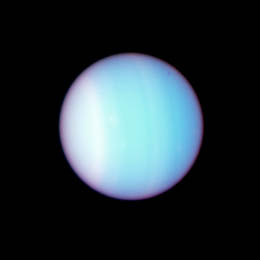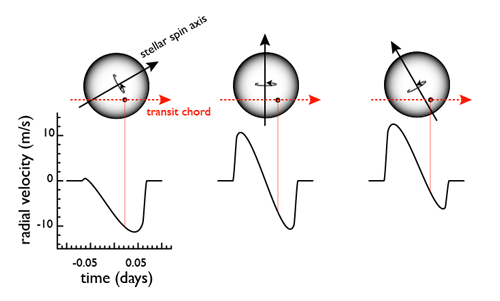HD 149026
aaron posted in exoplanet detection, worlds on March 24th, 2006
The Solar System was once a gigantic black cloud in space, imbued with a tiny overall spin in some particular random direction. The net spin of our ancient protostellar cloud is still manifest in today’s solar system. The planets all orbit the Sun in a direction counterclockwise as seen from above. The major planetary satellites (with the exception of Triton) all orbit counterclockwise as well. The Sun spins on an axis that lies within 7 degrees of the average orbital plane of the planet.

The law of conservation of momentum suggests that alien planetary systems should display a similar state of orbital affairs. When a planetary system forms more or less quiescently, and more or less in isolation, then the final spin axis of the parent star should be nearly perpendicular to the orbital plane of the planets.
If the stellar equator and the planetary orbital planes are far from alignment, then we have evidence that disruptive events occurred early in the history of the planetary system. Spin-orbit misalignment hints at planetary collisions, ejections, and other dramatic events. In the Solar System, for example, the crazy 97.77 degree tilt of Uranus’ polar axis may be evidence that a large (perhaps Earth-mass) object collided with Uranus early in its history, leaving its spin axis askew, and its poles bathed in an endless succession 42-year days.

In a new paper accepted for publication in the Astrophysical Journal, members of the systemic team have participated in an investigation of the spin-orbit alignment of the recently discovered transiting planet orbiting HD149026. Our goal was to get a better sense of whether this star-planet system suffered a catastrophe in its distant past.
HD 149026 b was discovered last year by N2K (the discovery paper is here). The planet has a mass ~114 times that of the Earth (slightly bigger than Saturn) and has a 2.875 day orbital period. By measuring how the star’s light dims as the planet passes in front of the star, it’s possible to determine the size and the exact orbital geometry for the system. Here’s a scale model in which the star, and the planet, and the orbit are all shown in their correct proportions:

Perhaps the most charming aspect of HD 149026 b (to the limited extent that a scalding 1600K planet can exert charm) is that the planetary sidereal year lasts exactly one weekend. That is, if you punch a clock at noon on Friday, the planet has made one full orbit at 9:01 am the following Monday.
Perhaps the most scientifically interesting aspect of HD 149026 b is its small size. The transit depth is only 0.3%, which implies that the planet has a radius of only ~0.7 Jupiter radii. That is surprisingly small, given the high temperature on the planetary surface, and tells us that the planet is quite dense. It needs to contain at least 50 Earth masses of elements heavier than hydrogen and helium. This huge burden of heavy elements is hard to explain. One possibility is that the planet was built up from the collision of several Uranus or Neptune like objects. If this were the case, then one might expect that the final orbital plane could be significantly misaligned with the equatorial plane of the star.
Our measurement of the spin-orbit alignment for HD 149026 makes use of a phenomenon known as the Rossiter-McLaughlin effect. In 1924, Rossiter and McLaughlin independently measured the spin-orbit alignment of the eclipsing binary systems beta-Lyrae and Algol by modeling the variations in the measured radial velocities of the stars during transit. This effect, now appropriately called the Rossiter-McLaughlin effect, occurs any time an object (star or planet) occults part of a rotating stellar surface. The following figure shows how a rotating star outputs a small red-blue shifted version of its spectrum as we examine the changing radial spin-velocity from one limb to the other. When a planet passes in front of the oncoming limb, it blocks out red-shifted light, while the planet blocks out blue-shifted light when covering the outgoing limb. This is interpreted by the radial velocity code as a positive and then negative shift in the radial velocity of the star. The amplitude of this effect is thus due both to the spin velocity of the star as well as the total flux blocked out during transit.

The Rossiter effect can be used to tell us how closely the stellar equator is aligned to with the orbital plane of the planet. When the planet’s path across the stellar disk is not parallel to the stellar equator, the radial velocity zero-point does not occur at the transit mid-point, and the radial velocity curve is asymmetric. The figure above illustrates how this works.
High-cadence radial velocity observations taken during a transit are required to accurately measure the Rossiter effect. The in-transit velocities can be combined with other data, including the out-of-transit radial velocities which constrain the planetary orbit, and the transit photometry. An overall coupled model of all of these data can then give us the best possible picture of the system. Our new paper describes the exact details of how such an overall model can be constructed for HD 149026. The end result is that the equator of the star and the orbital plane of the transiting planet are quite well aligned; we measure the value of the misalignment angle to be 11 plus or minus 14 degrees.
Although a fourteen degree (1-sigma) uncertainty is more than we’d like, it nevertheless provides an excellent constraint on the HD 149026 system. Since the misalignment of our own sun is ~7 degrees relative to the net planetary orbital angular momentum, and because we believe that the solar system formed fairly quiescently, we are primarily interested in whether HD 149026 b sports a severe misalignment (say 40 degrees or more). From our modelling, it’s clear that the orbit and planetary spin are not egregiously out of whack. Hence, there’s no evidence of a particularly disruptive formation history. That is, no catastrophic orbit altering collisions between massive protostellar cores. Rather, we are left with evidence of a more traditional, more mundane history, in which planetary formation was dominated by gradual accretion and the prolonged interactions with a planetary disk
And the mystery of HD 149026b’s large core persists. How did all those heavy elements — all that oxygen, nitrogen, carbon, iron, gold, get into the planet?
Our favored explanation draws on a scenario described by Frank Shu in 1995, in which the planetesimal migrates radially inward through the planetary disk until it reaches the interior 2:1 resonance with the “magnetic X-point,” the outermost point at which closed stellar magnetic field lines intersected the planetary disk. At the X-point, heated ionized gas is forced to leave the disk and climb up the field lines to accrete directly onto the star. In this occurs, the planetismal is stuck in a gas-starved environment for the remainder of the disk lifetime, and is essentially fed nothing but rocks and heavy elements for millions of years. The end result is a crazy-large 72 Earth-mass core in the middle of a 114 Earth-mass planet.
April 4th, 2006 at 11:55 pm
[…] Here at www.oklo.org we strive to keep things on the positive tip, but I do have one disappointing piece of news to report. I was a Co-I on Tim Brown’s recent HST Cycle 15 Proposal to obtain a high-precision photometric time series of the HD 149026 b transit. The resulting light curve would have had higher photometric precision than both the TrES-1 and HD 209458 b time series shown above. The light curve would have had a higher cadence, the individual points would have been good to about one part in 20,000. (At magnitude 8.16, HD 149026 is about thirty times brighter than TrES-1, and the new ACS camera on HSTT is better-suited to the photometric transit-measurements that the defunct STIS spectrograph that was used by Brown et al. for HD 209458). Unfortunately, we learned yesterday that the proposal has been rejected. This is a real bummer, given that the HST light curve would have dramatically improved our characterization of the planet. Already, HD 149026 b has provided the first uncontrovertible evidence for the core-accretion mechanism of giant planet formation. I think that the HD 149026 light curve would have been at as informative as the HD 209458 light curve, which was recently shown as #4 in the list of Hubble’s top ten scientific achievements. […]
April 23rd, 2006 at 1:29 am
[…] There are, however, scientifically compelling and unassailably selfless arguments for why it’s important to locate as many extrasolar planets as quickly possible. I think the most important reason is that quick-look radial velocity surveys (such as N2K) are the best way to locate planets that transit bright parent stars. Once identified, objects like HD 149026b yield up a simply incredible amount of information. […]
May 10th, 2007 at 7:40 pm
[…] The temperature difference between the hot spot and the cold spot for HD 189733 b is ~350 K, which indicates that the planet is doing a fairly good — but not perfect — job of equilbrating its day and night side temperatures. Equilibration does not, however, appear to be the order of the day on HD 149026 b. Harrington et al., in their Nature paper, measured HD 149026’s 8-micron flux before, during, and after the secondary transit. The secondary transit turned out to be remarkably deep, indicating that the planet is glowing very brightly in the 8-micron band. If the 8-micron emission is interpreted as arising from a blackbody, then the temperature of the substellar hemisphere is an incredibly hot 2300 K. This is more than 1000K hotter than the substellar hemisphere of HD 189733 b. […]
August 5th, 2007 at 6:41 pm
[…] On June 6th, Josh Winn and his collaborators used the Keck telescope to obtain 97 radial velocities for HAT-P-2. The observations were timed to occur before, during, and after primary transit, and the Rossiter-McLaughlin effect is clearly visible in their data (preprint here): […]